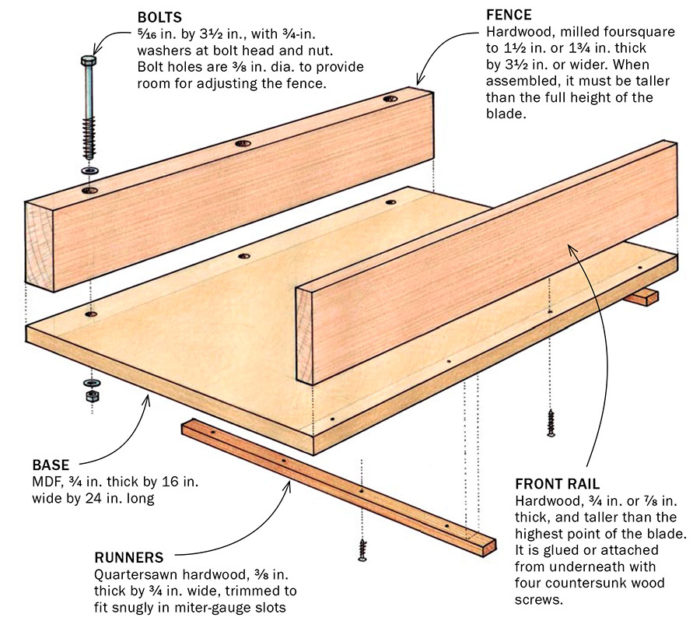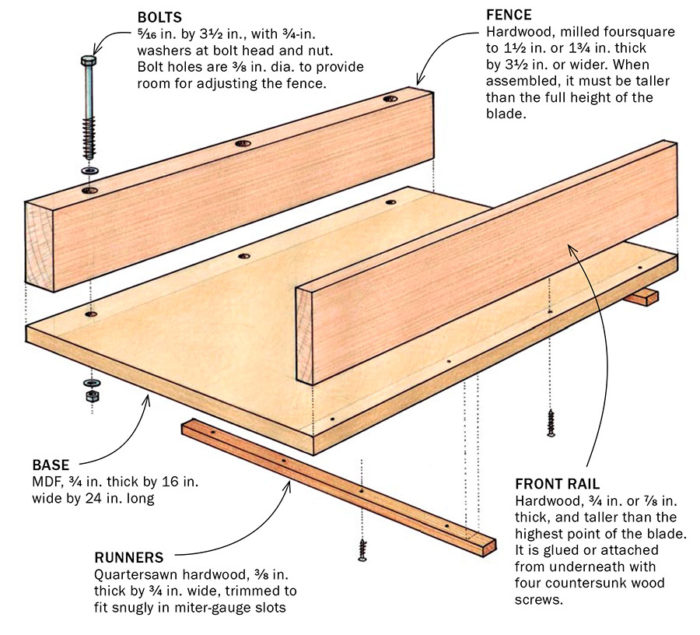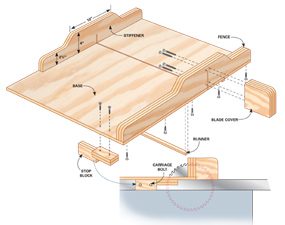Are you wondering how big your table saw sled should be? Well, you’re in the right place! We’re here to help you determine the perfect size for your sled, so you can work efficiently and safely. Let’s dive in and find out the ideal dimensions for your table saw sled.
When it comes to table saw sleds, size matters. The size of your sled will depend on the type of projects you’re working on and the space available in your workshop. But don’t worry, we’ll guide you through the process of finding the right dimensions for your sled.
Finding the perfect size for your table saw sled involves considering factors like the size of your table saw, the length of your workpieces, and the available workspace. By striking the right balance, you can optimize your sled’s performance and ensure accurate and safe cuts. So, let’s explore how to determine the ideal size for your table saw sled.
Wondering how big your table saw sled should be? Follow these steps for the ideal size:
1. Measure the width of your table saw surface.
2. Decide on the maximum width of the cuts you plan to make.
3. Add a few extra inches for safety and stability.
4. Consider the size of the materials you will be working with.
5. Keep in mind the available space in your workshop.
By following these steps, you’ll be able to determine the perfect size for your table saw sled.

How Big Should My Table Saw Sled Be?: A Guide to Choosing the Right Size
Table saw sleds are valuable tools for woodworkers, providing stability and precision when making cuts. But when it comes to choosing the right size for your table saw sled, it can be a bit confusing. The size of your table saw sled will depend on various factors, including the size of your table saw, the type of work you do, and your personal preferences. In this guide, we will dive into the considerations that can help you determine the ideal size for your table saw sled.
The Importance of Size
When it comes to table saw sleds, size matters. The size of your sled will determine the range of work you can do and the level of stability and accuracy it provides. A sled that is too small can limit your ability to work with larger pieces of material, while a sled that is too large can be cumbersome and difficult to control. Finding the right balance is essential for a table saw sled that is both versatile and easy to use.
The Size of Your Table Saw
One of the first factors to consider when determining the size of your table saw sled is the size of your table saw itself. The dimensions of your table saw’s table will dictate the maximum size of your sled. Measure the width and length of your table saw’s table, as this will be the maximum size that your sled can be. It’s important to ensure that your sled will fit comfortably and securely on the table for optimal performance and safety.
Ideally, your sled should be slightly smaller than the dimensions of your table saw’s table to allow for ease of movement and to prevent any interference with other accessories or components of your table saw. This will ensure that your sled is stable and doesn’t disrupt the functionality of your table saw.
The Type of Work You Do
Another crucial factor to consider is the type of work you typically do with your table saw. If you primarily work with small pieces of material or make precision cuts, a smaller sled may be more appropriate. A smaller sled offers better control and accuracy for intricate cuts. Conversely, if you frequently work with larger pieces of material or need to make crosscuts on wide boards, a larger sled will provide the stability and support you need.
Consider the types of projects you typically undertake and the sizes of the materials you work with. This will help you determine if a smaller or larger sled will best suit your needs. Remember that a well-sized sled will allow you to work efficiently and comfortably, resulting in better results and less frustration.
Your Personal Preferences
Ultimately, your personal preferences and comfort level should also play a role in determining the size of your table saw sled. Some woodworkers may prefer a smaller sled as it feels more manageable and easier to maneuver. Others may opt for a larger sled for increased stability and support. Assess your own comfort, experience level, and working style to find the right fit for you.
Experiment with different sizes and consider borrowing or testing sleds from other woodworkers to get a feel for what works best for you. Customizing your sled to your exact specifications ensures that you have a tool that perfectly suits your needs.
Benefits of Choosing the Right Size
Choosing the right size for your table saw sled offers several benefits. Firstly, it provides stability and control, allowing for precise and accurate cuts. A well-sized sled will prevent material from shifting or vibrating during the cutting process, resulting in cleaner and more professional-looking cuts.
Additionally, a properly sized sled ensures safety. When the sled fits the table saw’s table securely and doesn’t interfere with other components, it reduces the risk of accidents or injuries. It minimizes the chances of kickbacks or the sled coming loose during operation, providing a secure and trustworthy working environment.
Lastly, a well-fitted sled enhances efficiency and productivity. It allows you to work more comfortably and with confidence, enabling you to complete projects more quickly and with better results. By choosing a sled size that suits your needs, you can optimize your workflow and enjoy a smoother woodworking experience.
Tips for Getting the Most Out of Your Table Saw Sled
Now that you know the considerations for choosing the right size for your table saw sled, let’s explore some additional tips to help you get the most out of this versatile tool:
1. Use a Quality Material
When building your sled, consider using a high-quality material that is sturdy and durable. Plywood, Baltic birch, or medium-density fiberboard (MDF) are popular choices for sleds due to their strength and stability.
2. Ensure a Smooth Surface
Take the time to sand and smooth the surface of your sled. This will reduce friction and allow your workpieces to glide smoothly across the sled, preventing any snags or imperfections in your cuts.
3. Install a T-track System
Adding a T-track system to your sled can provide versatility and enhance its functionality. T-tracks allow for the attachment of various accessories such as stop blocks, hold-downs, and measuring devices, making your sled even more useful for different woodworking tasks.
4. Optimize Safety Features
Consider incorporating safety features into your sled design, such as a blade guard or a zero-clearance insert. These features can help prevent kickbacks and reduce the risk of accidents, ensuring a safer woodworking environment.
5. Regularly Maintain and Clean Your Sled
To ensure the longevity and optimal performance of your sled, it’s important to regularly clean and maintain it. Remove any sawdust or debris that accumulates, and inspect the sled for any signs of wear or damage. Making the necessary repairs and keeping your sled in top condition will guarantee its reliability and effectiveness.
Conclusion
Choosing the right size for your table saw sled is crucial for achieving precise, accurate, and safe cuts in your woodworking projects. Considering the size of your table saw, the type of work you do, and your personal preferences will help you determine the ideal dimensions for your sled. By customizing your sled to fit your needs, you’ll enjoy enhanced stability, control, and productivity in your woodworking endeavors. Combine this with the extra tips provided to optimize your sled’s performance and ensure a satisfying woodworking experience.
Key Takeaways: How Big Should My Table Saw Sled Be?
- A table saw sled should be large enough to accommodate the workpiece you’ll be cutting.
- Consider the size of your table saw’s surface and the available workspace in your workshop.
- Ensure that the sled is sturdy and can provide support and stability to the workpiece.
- Make sure the sled allows for accurate and precise cuts by offering enough guidance and control.
- Take into account your personal preferences and the types of projects you commonly work on.
Frequently Asked Questions
Welcome to our FAQ section on table saw sleds! Here we have compiled some commonly asked questions to guide you on how big your table saw sled should be.
1. What factors should I consider when determining the size of my table saw sled?
When determining the size of your table saw sled, you need to consider a few factors. Firstly, think about the size of your workpieces and the cuts you’ll be making. Take into account the maximum width and length of the materials you typically work with. Additionally, consider the available space in your workshop and how the sled will fit on your table saw. You want to ensure you have enough room for maneuvering while still having a stable and secure setup.
Another factor to consider is the weight of the sled. A larger sled may be heavier and more difficult to handle, especially if you work alone. If you anticipate moving the sled frequently, a smaller and lighter sled might be more suitable for your needs. Ultimately, the size of your table saw sled should align with your workflow, workspace, and the materials you work with.
2. What are the advantages of using a larger table saw sled?
Using a larger table saw sled can offer several advantages. Firstly, a larger sled provides more stability and support, especially when working with larger workpieces. It allows you to have better control over the material and reduces the risk of it tipping or moving during cuts. Additionally, a larger sled can accommodate larger crosscuts, enabling you to work with bigger stock.
Larger sleds also provide more surface area for clamping down workpieces, ensuring they are secure throughout the cutting process. Furthermore, a larger sled can allow for the addition of accessories such as stops, measuring guides, or hold-downs, making your workflow more efficient and accurate. Overall, a larger table saw sled can enhance your cutting precision and provide a more versatile working platform.
3. Are there any drawbacks to using a larger table saw sled?
While larger table saw sleds have their benefits, they also come with a few potential drawbacks. One consideration is the space required to store and use a larger sled. If you have limited workspace, a large sled may not be the most practical choice. Additionally, larger sleds tend to be heavier, making them more challenging to handle and transport.
Another potential drawback is that a larger sled may take longer to set up and adjust compared to a smaller sled. If you frequently need to make changes to accommodate different workpieces or cutting requirements, a smaller sled might provide more convenience. Ultimately, consider your specific needs, workspace limitations, and personal preferences when deciding on the size of your table saw sled.
4. Can I resize my table saw sled if I find it too big or too small?
In many cases, you can resize your table saw sled if you find it too big or too small for your needs. If you have a larger sled and wish to downsize it, you can easily trim down the sled’s dimensions using appropriate cutting tools. However, keep in mind that resizing a sled may require adjustments to other components, such as the fences or guides, to ensure they align properly with the new sled size.
If you have a smaller sled and want to make it larger, you can build extensions or add-ons using compatible material like plywood. Ensure the extensions are securely attached to the existing sled structure for stability. Remember to maintain the integrity and accuracy of the sled while making any modifications.
5. What are some general size recommendations for table saw sleds?
While the size of a table saw sled depends on individual preferences and specific requirements, there are some general size recommendations you can consider. For crosscutting tasks, a sled with a minimum width of about 12 inches (30 cm) is often recommended. This width allows for stability and support when cutting wider workpieces.
The length of the sled should be dictated by the maximum length of your typical workpieces, ensuring they can be fully supported on the sled’s surface. However, keep in mind that longer sleds may require more workspace and have additional weight. It’s crucial to find the right balance between size, functionality, and practicality for your specific needs.
Summary
If you’re wondering how big your table saw sled should be, remember these key points. First, consider the size of your materials and the type of cuts you’ll be making. Next, make sure the sled has enough support and stability. Lastly, don’t forget to account for safety features like a blade guard and push stick. With these factors in mind, you can build a table saw sled that is the right size for your needs.
In conclusion, when determining the size of your table saw sled, think about your materials, support, and safety. By considering these factors, you can create an effective sled for your woodworking projects. Happy sawing!

